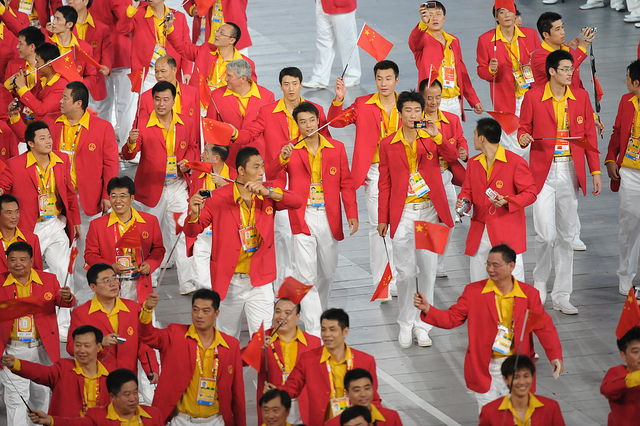The Olympics puts the best of humanity on display: in individual athletic prowess, in team spirit, and in a sense of global unity.
We celebrate the best of human achievement collectively.
But this year’s media coverage of the 2016 Olympics has been rife with blunders that also remind us just how thoroughly cultural biases have infiltrated our society.
For example, this headline about Chinese swimmer Ning Zetao appeared in my Facebook news feed a few days ago, causing a Twitter storm of protest:
The full headline reads: “Forget Zika Virus – China’s Hottest Olympic Swimmer is Giving the Internet Yellow Fever.”
Later, when Corey Cogdell-Unrein won the bronze medal for trap shooting, the Chicago Tribune’s Twitter feed read, “Wife of a Bears’ lineman wins a bronze medal today in Rio Olympics.” No mention of her name or her sport.
Wife of a Bears’ lineman wins a bronze medal today in Rio Olympics https://t.co/kwZoGY0xAX pic.twitter.com/VZrjOvr80h
— Chicago Tribune (@chicagotribune) August 7, 2016
And when the U.S. women’s gymnastics team won their qualifying round by a landslide, an unidentified NBC commentator remarked that “they might as well be standing in the middle of a mall” after their excited celebration was caught on camera.
Our cultural biases are so deeply ingrained that those who propagate them often have no idea that they’re perpetuating stereotypes. Even well-meaning gestures can backfire because they imply that certain populations could not succeed without benevolent assistance from a magnanimous majority.
I know this from first-hand experience. Many years ago, I filled out several scholarship applications to help fund my graduate education. A mere two weeks before the semester started, I received a letter offering a fully paid tuition. As expected, I was elated. I was ecstatic.
Then I was…nauseated.
My “scholarship” was actually a minority fellowship that I hadn’t even applied for. And, while it solved my immediate problem, it also unleashed enormous insecurity: Did I receive financing for my academic abilities or for my coveted equal opportunity status?
I set aside my discomfort to accept the fellowship, but, 27 years later, I’ll still never know the real reason I was selected.
There’s an ancient Chinese paradox that begins, “A white horse is not a horse.” While philosophers far wiser than I have debated its meaning for centuries, the essence of the argument is that the whiteness of the horse removes it from the unmodified category of horse. By specifying one particular feature, suddenly the white horse can no longer be counted among the undifferentiated horse population.
Therefore, a white horse is not a horse because it is a white horse.
Apply that logic to gender, religion, or race, and we have an interesting new perspective. For instance: A female human is not a human because she is a female human. She is now categorized and differentiated because of her femaleness.
Categorizing in itself is not inherently a bad thing. Much of the delight in the human experience lies in recognizing our differences and honoring them.
The problem is that we do not categorize fairly or equally. We conflate “human” with our own biases. In the society that we live in, this too often equates “human” with “white male human.”
All others fall into a different—and, by default, often an inferior—category that is separated by subtle and not-so-subtle slings and arrows.
When we remove certain people from the general population and then generalize about them, it becomes racism. And racism can be so pervasive and understated that we actually come to accept certain stereotypes as real.
As a Korean adoptee, I’ve had a unique glimpse into the many layers of racial and gender hierarchy in our society. My outer appearance has brought me lots of unwanted attention, especially from those buying into the stereotype of the submissive Asian doll. Once it’s clear that my Western behavior doesn’t mesh with their “Cherry Blossom” fantasy, the response can be, shall we say, pretty boorish.
Conversely, my so-called “white” comportment has elicited some unintentionally candid remarks from those who might otherwise monitor their thoughts and speech. Case in point: once, a co-worker went off on a snarky, mean-spirited tirade about “those Orientals,” poking fun at their mannerisms, looks and particularly, their eyes.
I stopped her and reminded her I, too, was one of “those.”
Her automatic response was, “No, you’re not!” Then she looked at me carefully, reddened and blurted out, “I forget what you look like because you act like one of us.”
In some ways, my co-worker’s response is a perfect example of how getting to know someone helps us see beyond superficial external appearances. It’s proof positive that sitting down together in mindful discourse is still the best way to cross cultural, racial, religious and gender divides.
But sadly, it’s also a reminder of how far we still have to go.
Author: Melinda J. Matthews
Image: U.S. Army/Flickr
Editor: Catherine Monkman












Read 0 comments and reply